Structure of the United States Space Force
The structure of the United States Space Force consists of four main bodies: the Office of the Secretary of the Air Force, the Office of the Chief of Space Operations, the field commands, and the space deltas.

Space Staff
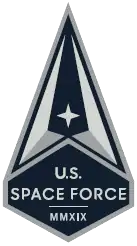
The Space Staff is the headquarters for the Space Force. Having initially been allotted 160 billets, it is responsible for organizing, training, and equipment of Space Force in FY 2021, cooperating with the Air Staff on support issues. It is headed by the chief of space operations and the vice chief of space operations who are both four-star generals, and the chief master sergeant of the Space Force. There is also a director of staff who oversees the staff action group, protocol, information technology and administration, resources, and total force integration groups.[1] The chief of space operations also have three deputy chiefs of space operations.
The office has the following structure:
- Chief of Space Operations
- Vice Chief of Space Operations
- Chief Master Sergeant of the Space Force
- Director of Staff
- Deputy Chief of Space Operations, Cyber, and Nuclear
- Deputy Chief of Space Operations for Strategy, Plans, Programs, Requirements, and Analysis
- Deputy Chief of Space Operations for Personnel and Logistics
Organization
The Space Force is organized as one of two coequal military service branches within the Department of the Air Force, with the other service being the United States Air Force. Both services are overseen by the secretary of the Air Force, who has overall responsibility for organizing, training, and equipping the Space Force and Air Force.[2]
The military head of the Space Force is the chief of space operations (CSO), who is an officer in the grade of general. The chief of space operations will become a member of the Joint Staff one year after the passage of the United States Space Force Act.
The Space Force field organizations consist of three different echelons of command: field commands, deltas, and squadrons. Field commands align with specific mission focuses and are led by officers in the grade of O-9 or O-8. Deltas are organized around a specific function, such as operations, installation support, and training, and are led by an officer in the grade of O-6. Squadrons are focused on specific tactics and are led by an officer in the grade of O-5.[3]
The Space Force's three field commands will be Space Operations Command (SpOC), Space Systems Command (SSC), and Space Training and Readiness Command (STARCOM). Space Operations Command will be the primary force provider of space forces and capabilities and commanded by an officer in the grade of O-9. SpOC will be activated at Peterson Air Force Base in the summer of 2020. The current Space Operations Command, formerly 14th Air Force, will be renamed. Space Systems Command will be responsible for developing, acquiring, and fielding space systems, as well as launch, developmental testing, on-orbit checkout, and sustainment and maintenance of space systems. It will also run Space Force science and technology activities. Led by an officer in the grade of O-9, SSC will be formed from the Space and Missile Systems Center, Commercial Satellite Communications Office, and other space systems programs offices transferred into the Space Force. Space Training and Readiness Command will train and educate space professionals, and develop combat-ready space forces. While STARCOM will be led by an officer in the grade of O-8, it will not be activated until 2021. In the interim, a Space Training and Readiness Delta will be established in July at Peterson AFB.[3]
On 20 December 2019, Air Force Space Command's principal components were 14th Air Force (Air Forces Strategic) and the Space and Missile Systems Center. At the same time as the creation of the Space Force 14th Air Force was redesignated as Space Operations Command.[4]
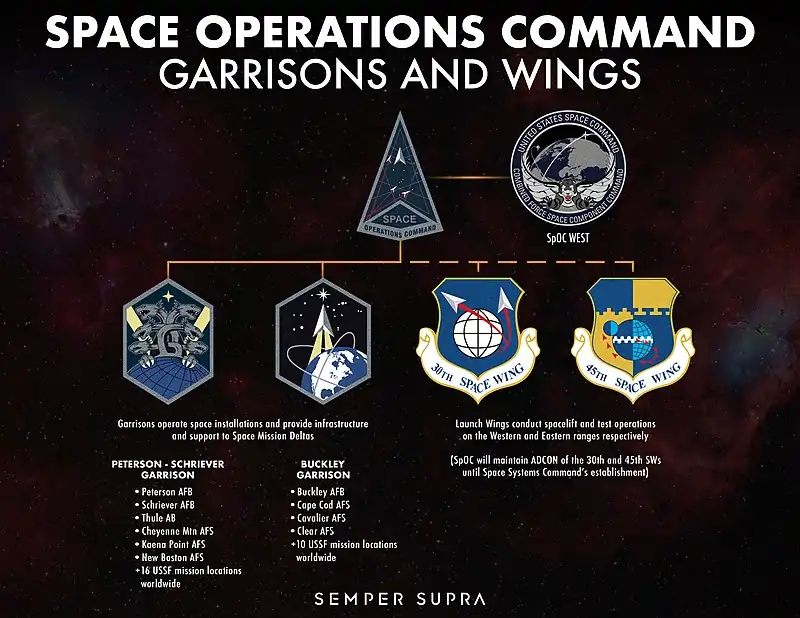
Structure
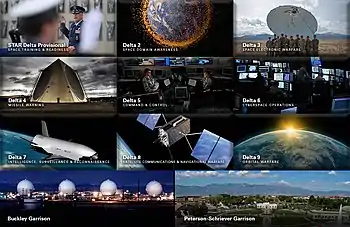
The Space Staff , The Pentagon, Arlington County, Virginia
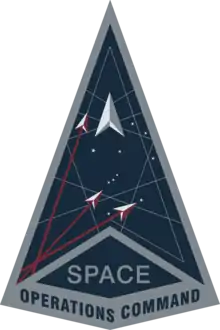 Space Operations Command (SpOC), Peterson Air Force Base, Colorado
Space Operations Command (SpOC), Peterson Air Force Base, Colorado
- Space Operations Command West, Vandenberg Air Force Base, California[5]
.svg.png.webp) Space Training and Readiness Delta Provisional (STAR Delta), Peterson Air Force Base, Colorado
Space Training and Readiness Delta Provisional (STAR Delta), Peterson Air Force Base, Colorado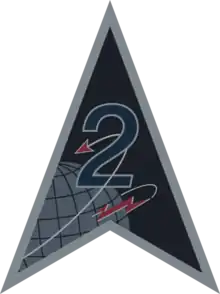 Space Delta 2 (Space Domain Awareness), Peterson Air Force Base, Colorado
Space Delta 2 (Space Domain Awareness), Peterson Air Force Base, Colorado Space Delta 3 (Space Electronic Warfare), Peterson Air Force Base, Colorado
Space Delta 3 (Space Electronic Warfare), Peterson Air Force Base, Colorado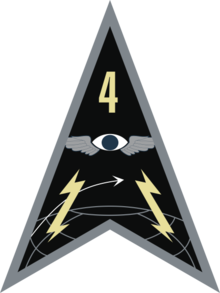 Space Delta 4 (Missile Warning), Buckley Air Force Base, Colorado
Space Delta 4 (Missile Warning), Buckley Air Force Base, Colorado Space Delta 5 (Command and Control), Vandenberg Air Force Base, California
Space Delta 5 (Command and Control), Vandenberg Air Force Base, California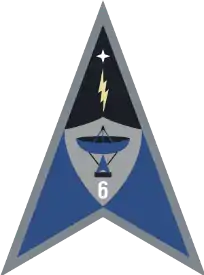 Space Delta 6 (Cyberspace Operations), Schriever Air Force Base, Colorado
Space Delta 6 (Cyberspace Operations), Schriever Air Force Base, Colorado Space Delta 7 (Intelligence, Surveillance, and Reconnaissance), Peterson Air Force Base, Colorado
Space Delta 7 (Intelligence, Surveillance, and Reconnaissance), Peterson Air Force Base, Colorado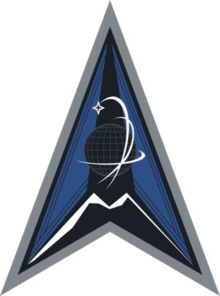 Space Delta 8 (Satellite Communication/Navigation Warfare), Schriever Air Force Base, Colorado
Space Delta 8 (Satellite Communication/Navigation Warfare), Schriever Air Force Base, Colorado Space Delta 9 (Orbital Warfare), Schriever Air Force Base, Colorado
Space Delta 9 (Orbital Warfare), Schriever Air Force Base, Colorado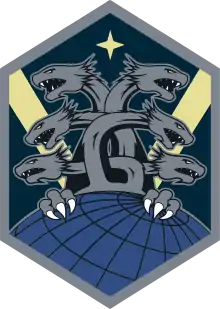 Peterson-Schriever Garrison, Peterson Air Force Base, Colorado
Peterson-Schriever Garrison, Peterson Air Force Base, Colorado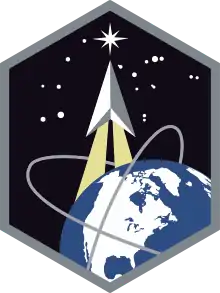 Buckley Garrison, Buckley Air Force Base, Colorado
Buckley Garrison, Buckley Air Force Base, Colorado 30th Space Wing (30 SW), Vandenberg Air Force Base, California
30th Space Wing (30 SW), Vandenberg Air Force Base, California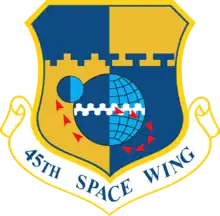 45th Space Wing (45 SW), Patrick Space Force Base, Florida
45th Space Wing (45 SW), Patrick Space Force Base, Florida
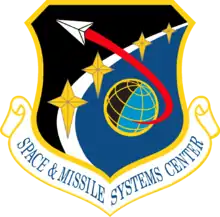 Space and Missile Systems Center (SMC), Los Angeles Air Force Base, California
Space and Missile Systems Center (SMC), Los Angeles Air Force Base, California
On 12 March 2019, the Space Development Agency (SDA), a new space-focused development agency, additional to the Space and Missile Systems Center and the Space Rapid Capabilities Office, was established.[6] It was established under the authority of the under secretary of defense for research and engineering.[7] As of January 2020, the SDA is planned to become part of the U.S. Space Force in October 2022.[8]
In early April 2020, a list of twenty-three units to be transferred from the Air Force to the Space Force was publicly reported.[9] Those units included the 17th Test Squadron, Peterson Air Force Base, Colorado; 18th Intelligence Squadron, Wright-Patterson AFB, OH; the 25th Space Range Squadron, Schriever AFB, CO; the 328th Weapons Squadron, Nellis AFB, NV; the 527th Space Aggressor Squadron, Schriever AFB, CO; the 7th Intelligence Squadron, 659th Intelligence, Surveillance and Reconnaissance Group, 70th ISR Wing, Ft. Meade, Maryland*; Sixteenth Air Force/Advanced Programs*, Schriever AFB, Colorado; the 32nd Intelligence Squadron, Ft. Meade, Maryland*; the 566th Intelligence Squadron, Buckley AFB, Colorado*; the 544th Intelligence, Surveillance and Reconnaissance Group, Group Staff & Detachment 5, Peterson AFB, Colorado; D the 533d Training Squadron, 381st Training Group, Vandenberg AFB, CA (initial training); the Air Force Research Laboratory (AFRL) Research Lab Mission Execution, Wright-Patterson AFB, Ohio*; the AFRL Space Vehicles Directorate, Kirtland AFB, New Mexico*; the AFRL Rocket Propulsion Division, Edwards AFB, CA; the AFRL Electro-Optical Division, Maui, Hawaii & Kirtland AFB, New Mexico*; the AFRL Sensors Directorate, Wright-Patterson AFB, Ohio*; the Counter-Space Analysis Squadron and the Space Analysis Squadron, collectively half of the Space and Missiles Analysis Group, National Air and Space Intelligence Center, both at Wright-Patterson AFB; the Air Force Operational Test and Evaluation Center Detachment 4, Peterson AFB, CO; and the Air Force Safety Center – Space Safety Division, Kirtland AFB, New Mexico.
Detachment 1, USAF Warfare Center, Schriever AFB, Colorado; Operating Location A, 705th Combat Training Squadron, Schriever AFB, Colorado (ultimately part of the 505th Command and Control Wing), and the National Security Space Institute, Peterson AFB, CO National Security Space Institute, a place for space education became eventually part of the STAR Delta.
References
- "SKM_C3851FS20020412000" (PDF). Retrieved 2020-03-13.
- U.S. Department of Defense (February 2019). "United States Space Force Strategic Overview" (PDF). defense.gov. Retrieved 11 May 2019.
- Kirby, Lynn (30 June 2020). "USSF field command structure reduces command layers, focuses on space warfighter needs". United States Space Force. Retrieved 30 June 2020.
- Chiles, Cody (27 December 2019). "14th Air Force Redesignated as Space Operations Command". United States Space Force. Retrieved 30 June 2020.
- https://www.spoc.spaceforce.mil/About-Us/About-Space-Operations-Command
- Browne, Ryan (13 March 2019). "Pentagon launches development agency seen as key to future Space Force". CNN. Retrieved 22 January 2020.
- See https://www.cto.mil/ (accessed May 2020).
- Valerie Insinna (21 January 2020). "Space Development Agency on track to become part of Space Force in 2022, director says". Defense News. Retrieved 15 May 2020.
- Erwin, Sandra (31 March 2020). "U.S. Air Force to transfer 23 units to the Space Force". SpaceNews. Retrieved 30 June 2020.
